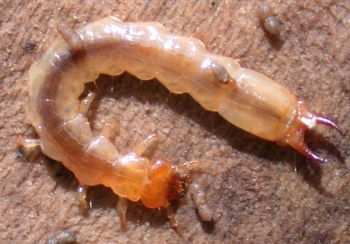|
|
ARTHROPODS:
Insects»
Spiders»
Centipedes»
Millipedes»
Sowbugs»
Harvestmen»
Mites
& Ticks»
Scorpions»
Identification
Tips»
About
the Critter Files»
Links» |
|
|
|
 |
FIRE-COLORED
BEETLES
Critter
Files/Insects/Beetles/Fire-Colored
Beetles
By Blake Newton
University of Kentucky Department of Entomology |
| |
|
| |
| TAXONOMY |
KINGDOM: Animalia
| PHYLUM: Arthropoda | CLASS: Insecta | ORDER:Coleoptera | FAMILY:Pyrochroidae (fire-colored beetles) |
| |
| Other
Names: Pyrochroids |
| |
WHAT
IS A FIRE-COLORED BEETLE?
LIFE CYCLE
ECOLOGY
PEST STATUS
COMMON KENTUCKY FIRE-COLORED BEETLES
COLLECTING & PHOTOGRAPHY
FIRE-COLORED BEETLE LINKS
MYTHS, LEGENDS, AND FOLKLORE |
| |
| WHAT
IS A FIRE-COLORED BEETLE? |
|
Like all beetles, Fire-Colored
Beetles (family Pyrochroidae) have chewing mouthparts and
hardened front wings (elytra) that meet in a straight line down
the back of the abdomen when closed. Commonly encountered Kentucky fire-colored beetles are a little less than 1" long. Some species are much smaller. Most have dark elytra (wing covers) and many are marked with orange or red on the head, legs, or thorax. Some species are orange all over their bodies. Fire-colored
beetles have long, straight antennae, and many individuals (especially males of certain species) have distinct "pectinate" (comb-like) antennae. |
| |
 Fire-colored beetle antenna, showing comb-like extensions (R. Bessin, 2000)
Fire-colored beetle antenna, showing comb-like extensions (R. Bessin, 2000) |
| |
| Like all beetle larvae, fire-colored beetle larvae look completely different than the adults. Larvae are long and worm-like with distinct, flattened bodies and horn-like projections on the final abdominal segment. |
| |
|
| SIZE:
Adult and larval body length up to about 1" |
| |
| LIFE
CYCLE |
|
Like
all beetles, fire-colored beetles undergo a complete metamorphosis
with egg, larval, pupal, and adult stages. Females lay eggs on decaying wood. Upon hatching in the summer, larvae live and
feed underneath the loose bark of decaying trees. As they grow, larvae shed their skins several times before pupating. Adults emerge during the summer.
|
| |
 Fire-Colored
Beetle larva (B. Newton, 2004)
Fire-Colored
Beetle larva (B. Newton, 2004) |
| |
| ECOLOGY |
|
Fire-colored beetle larvae are commonly found underneath the loose bark of decaying trees in Kentucky forests. Little is known about the biology of the larvae, but they are believed to be predators and likely feed on other wood-dwelling invertebrates like worms, termites, ants, and other beetle larvae. Larvae are slow moving and soft bodied, so they are easy prey for larger predators, especially centipedes, which live in the same habitat. Less is known about adult fire-colored beetles, but they have been observed visiting flowers where they probably feed on pollen and nectar. |
| |
| PEST
STATUS |
|
Fire-colored beetles are not considered pests. Because the larva live under the bark of dead wood, they are sometimes seen on firewood that is brought into the home. Read our ENTfact for more information about Firewood Insects. |
| |
| COMMON
KENTUCKY FIRE-COLORED BEETLES |
|
|
Neopyrochroa spp.
GENUS: Neopyrochroa |
| In Kentucky, there are two species of fire-colored beetles that belong to the genus Neopyrochroa. Pictured below is N. femoralis. Fire-colored beetles in the genus Dendroides are also common in Kentucky. |
| |
 Fire-Colored Beetle, Neopyrochroa femoralis (R. Bessin, 2000)
Fire-Colored Beetle, Neopyrochroa femoralis (R. Bessin, 2000) |
|
| |
| COLLECTING
& PHOTOGRAPHY |
|
Adult fire-colored beetles are typically slow-moving, so they are easy to capture or photograph. They are not always easy to find, though. Look in Kentucky forests during summer months. Fire-colored beetles may also occasionally come to lights at night. Fire-colored beetle larvae are easier to find than adults. Look under the loose bark of decaying trees. Larvae are slow-moving and easy to capture. Like all insect larvae, fire-colored beetles should be preserved in ethyl alcohol if kept as part of an insect collection.
|
| |
| MYTHS
- LEGENDS - FOLKLORE |
|
Do you know any myths, legends, or folklore about fire-colored beetles? If so,
let us know! |
| |
Original document: 5 July 2006
Last updated: 1 May 2008
Photos courtesy R. Bessin and B. Newton, University of Kentucky
The Kentucky Critter
Files are maintained by Blake Newton, Department of Entomology, University
of Kentucky.
Contact: blaken@uky.edu |
|

